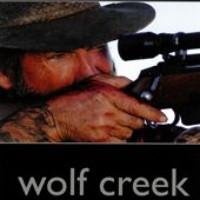Undoubtedly, the film’s distinctive reworking of Australia’s (cinematic and historical) past and its dark portrait of the nation’s interior landscape were reasons why Wolf Creek was selected as part of the Australian Screen Classics series of publications aimed at nurturing our national screen culture. It’s this darkness that author Sonya Hartnett (Thursday’s Child) also uses as her entry point into her discussion of the film.
Prefacing the work with a story about a childhood holiday to a country farm, replete with a bloated animal corpse, snarling dogs and a fearsome farmer, Hartnett establishes a personal context through which to understand her experience of Wolf Creek. Likening the themes of her writing (“Australian Gothic”) to those in McLean’s film, she concludes by proposing a kind of stylistic similarity across their work: “something like two-bit antipodean horror” (p.4).
That the narrative of Wolf Creek reflects artistic concerns within Hartnett’s prose is evident in what follows. The main body of the publication is essentially an embellished novelisation of the plot of the film, interspersed with brief references to the lives and actions of convicted murderers Ivan Milat and Bradley John Murdoch. Hartnett’s primary intention here appears to be elucidating similarities between these real-life crimes and those depicted on-screen, and the way such parallels inflect the viewer’s experience of horror. As she suggests:
“A horror movie plays to its audience, wanting it to squirm and even chuckle in appalled appreciation of events. But can a non-psychopathic viewer comfortably chuckle over some agony which was truly inflicted, the loss of a character based on a person who once lived and breathed?” (p.5)
The central flaw in Hartnett’s approach here is that Wolf Creek, regardless of the crimes or individuals that may have inspired the work, is neither the tale of Milat nor Murdoch nor that of their victims. It’s one thing to interrogate the textual implications of a film that broadly claims to be based on actual events but to suggest that the narrative’s fictionalised characters “detract from the truth of those who really did endure those events on which the film is based” (p.50-51) is problematic indeed. The simplistic and reductive conflation of reality with representation here undoes the potential for what might’ve been an illuminating critique of Wolf Creek in the context of Australia’s recent cultural past.
The other key drawback to Hartnett’s analysis is that for all the references to horror cinema, the publication contains no contextual examples from the genre to support any of her observations. A contrast with American horror films such as The Texas Chain Saw Massacre (1974) and The Hills Have Eyes (1977) or their contemporary remakes, or a comparison with the so-called ‘torture porn’ franchises listed earlier, could’ve yielded some interesting insights. Instead, we’re left with generalised statements and pseudo-profundities [“Wolf Creek is a horror movie, or a movie about horror” (p.20), and “This is not simply a horror film: it is frequently a film in which horror happens” (p.50)] that weaken the book’s critical claims.
It’s not just the treatment of genre that feels under-explored. Other culturally significant aspects of Wolf Creek are only hinted at. For instance, the construction of the landscape, either as a contrast with other Australian films (eg. The Tracker (2002) or Australia (2008)) or as a space of the white man’s violence, could’ve proved fascinating. So too the way the menacing figure of Mick (John Jarratt) demythologises the image of the ‘larrikin frontiersman’ personified in the past through characters like Crocodile Dundee (Paul Hogan) warranted closer inspection.
Considering the brevity of the publication though, it may be unfair to criticise the work for what it leaves out of its analysis. Likewise, given Hartnett’s literary background, it may seem unreasonable to denounce the text for not providing a closer examination of Wolf Creek in respect of its cinematic techniques and structures. However, since this series is aimed at investigating the “aesthetic, moral, intellectual and sentient value of our national cinema”, it’s hard not to overlook these shortcomings.
Love it or loathe it, Wolf Creek marks out a controversial but significant moment within contemporary Australian cinema and deserved a more accomplished contribution. The development of a successful screen culture depends upon it.
Wolf Creek
By Sonya Hartnett
Currency Press – Australian Screen Classics
ISBN: 978-0-86819-912-2
65 pages
RRP $16.95





